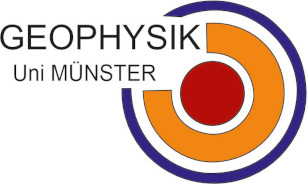D" reflector and post-perovskite
For many years, reflections from the lowermost mantle have been observed and since the early 80s they have been interpreted as a reflector in the lowermost mantle, where velocity and density change.
We also looked at this reflector in the lowermost mantle, the D" region, with seismic array data - for example beneath Siberia, Thomas and Weber (1997) found clear evidence in P and S-waves for this reflector using the Gräfenberg array and the German Regional Seismic network (see figure below). Several more studies detected and mapped this reflector (see literature list below).

Mapping this reflector showed topography of around 100 km and more in different regions, the average depth, however, is mostly around 2600 km. Two examples for Eurasia and the Caribbean are shown below. Another interesting observation is the presence of a second, lower reflector in these regions with less topography. And we also found that the polarities of the reflections for P and S-waves vary. While the S-wave has a positive reflection coefficient, the P-wave polarity beneath the Caribbean is negative.
Several possible causes for the D" reflector have been presented in the literature (see for example the list given in the review by Cobden et al., 2015). While a subducted slab would be a good explanation, the jump in velocity needs to relatively sudden (sharp discontinuity) to allow short-period P-waves to be reflected (see for example the seismogram above, filtered around 1 Hz). The variable velocity contrast is also providing some argument against a colder, purely thermal slab.

The post-perovskite phase transition (bridgmanite to post-perovskite) offers an explanation for several structures found in the D" region. It also allows to explain the double reflectors (see Hernlund et al., 2005) and the opposite (apparent) velocity jumps for P- and S-waves beneath the Caribbean. The variable P-wave contrast, as observed in high-velocity regions beneath the Caribbean and Eurasia, however, can be explained by a phase transition to post-perovskite and aligned material below the phase transition (see Thomas et al., 2011 and the project D" anisotropy).
It could, however, also be that different material is present in this region of D", see Cobden and Thomas 2013 and Cobden et al., 2015. The presence of MORB would for example change the polarity of the reflection for P-wave but not for S-waves.

In any case, the D" has been mapped in several regions and we continue to map it (e.g. Thomas and Laske 2015) using data from OBS but also noise (Poli et al., 2015).
As part of this effort, Stephanie Durand's project HAADES contributes to mapping reflectors in D" using earthquake data and noise.
For more information please see for example:
Cobden, L. and C. Thomas, The origin of D" reflections: a systematic study of seismic array datasets, Geophys. J. Int., 194, 1091-1118 doi:10.1093/gji/ggt152, 2013.
Poli, P., Thomas, C., M. Campillo, H. Pedersen, Imaging the D" reflector with noise correlations, Geophys. Res Lett., 42, 2014GL062198, DOI: 10.1002/2014GL062198, 2015.
Thomas C. and G. Laske, D" observations in the Pacific from PLUME Ocean Bottom Seismometer recordings, Geophys. J. Int., 200, 851-862 doi:10.1093/gji/ggu441, 2015.
Cobden, L.J., Thomas, C., Trampert, J., Seismic Detection of post-perovskite inside the Earth, in The Earth's heterogeneous mantle, ed: F. Deschamps, Springer 2015
Hernlund, J.W, C. Thomas, P.J. Tackley, Phase boundary double crossing and partial melting in Earth's deepest mantle, Nature, 434, 882-886, 2005
Thomas, Ch. and M. Weber. P-velocity heterogeneities in the lower mantle
determined with the German Regional Seismic Network: Improvement of previous models and results of 2D modelling. Phys. Earth Planet. Inter., 101, 105-117, 1997.
Thomas, C. J-M. Kendall & M. Weber. The lowermost mantle beneath northern Asia:
(1) Multi--azimuth studies of heterogeneity, Geophys. J. Int., 151, 279-295, 2002
Thomas, C., E.J. Garnero and T. Lay, High-resolution imaging of lowermost mantle structure under the Cocos plate, J. Geophys., Res., 109, B08307 10.1029/2004JB003013, 2004
Thomas, C., J-M. Kendall and J. Lowmann, Lower mantle seismic discontinuities and the thermal morphology of subducted slabs, Earth Planet. Sci., Lett., 225, 105-113, 2004

